ISSN ONLINE(2319-8753)PRINT(2347-6710)
ISSN ONLINE(2319-8753)PRINT(2347-6710)
| Nagaanjeneyulu.K1 Avinash.M2 Shanmuka Srinivas. M3 Nagaanjeneyulu.K,1 Avinash.M2 Shanmuka Srinivas. M3 |
| Related article at Pubmed, Scholar Google |
Visit for more related articles at International Journal of Innovative Research in Science, Engineering and Technology
Our work focuses on the optimization of cutting tool life of a CNC milling machine and end milling operation is performed on it by using Poly Crystalline cubic Boron Nitride (PCBN) as the cutting tool material and En8 steel (HRC 46) as work piece material to predict the tool life. Data is collected from CNC milling machine which is run by different samples of experiments using software. The input of the model consists of feed rate, cutting speed and depth of the cut while the output from the model is the Tool life which is calculated by Taylor’s tool life equation. This research is to test the collecting data by Taguchi method. The model is validated through a comparison of the experimental values with their predicted counterparts. The optimization of the tool life is studied to compare the relationship of the parameters involved. The result of the analysis shows that depth of cut was the only parameter found to be significant. The analysis also shows that the predicted values and calculated values are very close, that clearly indicates that the developed model can be used to reduce the cost of machining.
Keywords |
| Optimization, Tool Life, Taguchi method. |
INTRODUCTION |
| The Computer Numerical Control (CNC) machine refers to the automation of machine tools to produce the good quality of work pieces. The production of low cost and good quality of work pieces compose of various factors. The research study found that the parameters are the main factors of lathing to get the job done. Meanwhile it is the factor of fixing tool life. If the selection of parameters is not correct, it will cause the shorter tool life. This will cause the impact of cost of production which could not compete to market effectively. Even though the machine tool industry in India has made tremendous progress, the metal cutting industries continue to suffer from a major drawback of not running the machine tools at their optimal operating condition. The problem of arriving at the optimum levels of the process parameters has attracted the attention of the researchers and practicing engineers for a very long time. In order to establish an adequate functional relationship between the tool life and cutting parameters (cutting speed, feed rate, depth of cut), a large number of tests are needed requiring a separate set of tests for each and every combination of cutting tool and work piece material. Most researchers have investigated the effects of these cutting parameters on tool by the one-variable-at-a-time approach. The present work takes into account the simultaneous variation of speed, feed rate and depth of cut and predicts the tool life of the material. The maintenance activity plays a major role in industrial systems as it permits to improve the availability, reliability and security, while reducing the life cycle cost. Among different types of milling processes, end milling is one of the most vital and common metal cutting operations used for machining parts because of its capability to remove materials at faster rate with a reasonably good surface quality. Also, it is capable of producing a variety of configurations using milling cutter. In recent times, computer numerically controlled (CNC) machine tools have been adopted to make the milling process fully automated. |
| In our work Taguchi’s approach is used to analyze the effect of milling process parameters – cutting speed, feed and depth of cut, on tool life of Poly Crystalline Cubic Boron nitride (PCBN) while machining En8 steel (HRC 46) and to obtain an optimal setting of these parameters that may result in optimizing tool life. |
II. LITERATURE SURVEY |
| [1] Kilickapet. al. investigated tool wear and surface roughness in machining of homogenized Sic-p reinforced aluminum metal matrix composite. They found that tool wear was mainly affected by cutting speed, increased with increasing cutting speed. Tool wear was lower when coated cutting tool was used in comparison to uncoated one. Surface roughness influenced with cutting speed and feed rate. Higher cutting speed and lower feed rates produced better surface quality. |
| [2] Luo et al. carried out theoretical and experimental studies to investigate the intrinsic relationship between tool flank wear and operational conditions in metal cutting processes using carbide cutting inserts. The authors developed the model to predict tool flank wear land width which combined cutting mechanics simulation and an empirical model. The study revealed that cutting speed had more dramatic effect on tool life than feed rate. |
| [3] Ishan B Shah, Kishore. R. Gawande conducted an experiment on Optimization of Cutting Tool Life on CNC Milling Machine through Design of Experiments by milling stainless steels s.s-304 and determined the tool life. |
| [4] Hari Singh conducted an experiment on Optimizing Tool Life of Carbide Inserts for Turned Parts using Taguchi’s Design of Experiments Approach by turning En24 steel (0.4 % C).Their objectives to obtain an optimal setting of turning process parameters –cutting speed, feed and depth of cut, which may result in optimizing tool life of Tic coated carbide inserts while turning En24 steel (0.4 % C). The effects of the selected process parameters on the tool life and the subsequent optimal settings of the parameters have been accomplished using Taguchi’s and design of experiments approach. The results indicate that the selected process parameters significantly affect the mean and variance of the tool life of the carbide inserts. The percent contributions of parameters as quantified in the S/N pooled ANOVA envisage that the relative power of feed (8.78 %) in controlling variation and mean tool life is significantly smaller than that of the cutting speed (34.89 %) and depth of cut (25.80 %). The predicted optimum tool life is 20.19 min. The results have been validated by the confirmation experiments. |
| [5] Anjan Kumar Kakati, M. Chandrasekaran, AmitavaMandal, and Amit Kumar Singh done an experiment on Prediction of Optimum Cutting Parameters to obtain Desired Surface in Finish Pass end Milling of Aluminum Alloy with Carbide Tool using Artificial Neural Network method. An artificial neural network (ANN) is used to establish the relationship between the surface roughness and the input cutting parameters (i.e., spindle speed, feed, and depth of cut). The Mat lab ANN toolbox works on feed forward back propagation algorithm is used for modeling purpose. 3-12-1 network structure having minimum average prediction error found as best network architecture for predicting surface roughness value. The network predicts surface roughness for unseen data and found that the result/prediction is better. |
 |
III. SELECTION OF WORK AND TOOL MATERIAL |
| Grey iron is one of the oldest cast ferrous products. In spite of competition from newer materials and their energetic promotion, gray iron is still used for those applications where its properties have proved it to be the most suitable material available. Gray iron castings are readily available in nearly all industrial areas and can be produced in foundries representing comparatively less investments. |
 |
IV. ABOUT PCBN |
| Polycrystalline cubic boron nitride (PCBN) composites are produced by sintering micron CBN (cubic boron nitride) powders with various ceramics, so as to produce extremely hard and thermally stable tooling materials. Most PCBN materials are integrally bonded to a cemented carbide substrate. CBN is the second hardest material known after synthetic diamond, but has high thermal and chemical resistance properties. PCBN composites provide extreme resistance to deformation and wear at high temperatures – typically an order of magnitude better than the nearest ceramic materials. Cubic boron nitride is the second hardest material in the world. It is considerably harder than the oxide, nitride and carbide ceramics which are commonly used for abrasive applications. Where a polycrystalline material is required for cutting tools, CBN particles of the order of 1 - 10 microns are sintered with a variety of ceramic and metal phases using ultra-high pressures and temperatures to produce a solid, sizeable mass of ‘PCBN’ (‘P’ denoting the polycrystalline form). |
| Since their development over a quarter of a century ago, PCBN materials have found widespread use in machining particular classes of work piece material. They have evolved to such an extent that many individual grades of PCBN have since been developed, each grade being tailored to meet the demands of specific metal cutting applications. |
V. WORK PIECE MATERIAL |
| The work piece material selected for investigation is EN 8 steel. En 8 finds wide varieties of application not only for forging, casting, axel shaft, crank shaft and connecting rods but also used for low cost die material in tool and die making industries. This steel can be hardened and tempered to provide a greater strength and wear resistance in comparison in low carbon steels. |
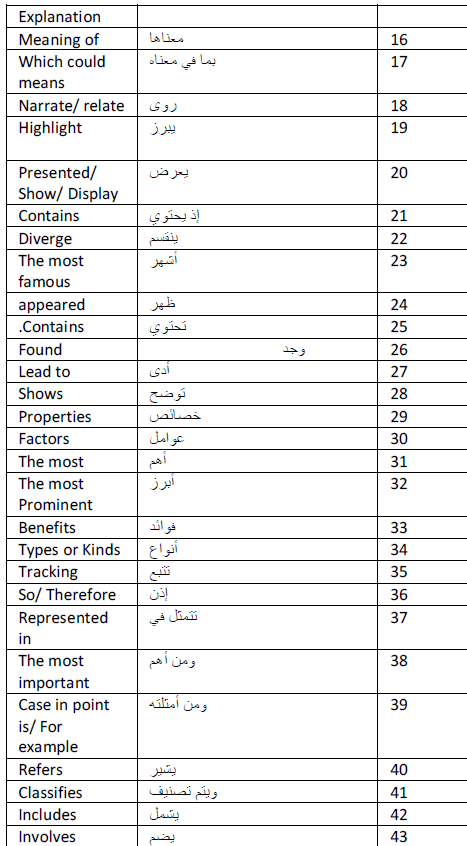 |
VI. SELECTION OF CONTROL PARAMETERS AND THEIR LEVELS |
| The process parameters affecting the characteristics of turned parts are: cutting tool parameters tool geometry and tool material workpiece related parameters- metallographic, hardness, etc.; cutting parameters- cutting speed, feed, depth of cut, dry cutting and wet cutting. |
VII. SELECTION OF CUTTING SPEED |
| Available literature on machining indicates that the influence of cutting speed on cutting forces and surface roughness changes with the cutting speed. Similarly, the effect of cutting speed on surface roughness has not been clearly understood so far. Most of the researchers have reported improvement in surface roughness with an increase in cutting speed. Also researchers, who have studied tool wear pattern, suggest to take increasing level of cutting speed which allows better understanding of wear patterns. Machine constraint is another reason for selection of cutting speed. |
VIII. SELECTION OF FEED |
| It is known from the fundamentals of metal cutting that feed rate influences the chip cross sectional area and hence the machining forces. It influences pitch of the machined surface profile and hence the machined surface roughness too An increase in feed rate increases the amount of cracks, pits on the machined surfaces due to reinforcement pull-out and fracture, which then deteriorates the surface quality/integrity and introduces higher thermal stresses on the machined surfaces. Also, effect of change in tool geometry in conjunction with feed rate on the surface quality/integrity is not adequately clear too. |
IX. SELECTION OF DEPTH OF CUT: |
| It is known that depth of cut influences the chip load by change in chip cross-sectional area and hence the cutting forces, which in turn could influence the stability of the machining process and machined surface characteristics. The surface roughness deteriorates with an increase in depth of cut, which is attributed to the formation of unstable BUE at lower feed and higher depth of cut. However, most of the investigations have reported that surface roughness has little and/or no dependence on depth of cut. Further, it is envisaged that a change in depth of cut may vary the rate of plastic deformation. This in turn influences the mechanical and thermal stresses and changes the residual stresses on the machined surfaces. Considering the literature review and the available machine settings following process parameters were selected for the present work: |
| a. Cutting speed b. Feed c. Tool material |
| d. Depth of cut |
| The ranges of the selected process parameters were ascertained by conducting some preliminary experiments using one variable at a time approach. The selected parameters were kept fixed during the entire experimentation. |
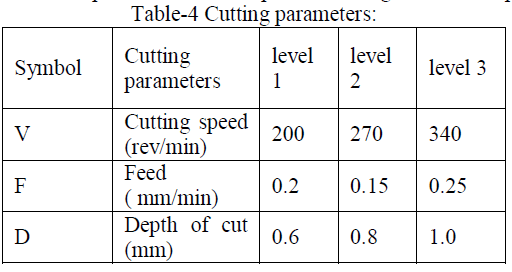 |
X. SELECTION OF ORTHOGONAL ARRAY |
| In Taguchi method-based design of experiments, to select an appropriate orthogonal array for experimentation, the total degrees of freedom (DOF) needs to be computed. The DOF is defined as the number of comparisons between machining parameters that need to be made to determine, which level is better and specifically how much better it is. For example, a three-level machining parameter has two DOF. The DOF associated with interaction between two machining parameters are given by the product of the DOF for the two machining Parameters. In the present study, interactions between the three machining parameters will be considered. Therefore, there are 18 DOF owing to three three-level independent parameters. In this study, a L27 orthogonal array has been used because it has 26 DOF, which is higher than 18 DOF of the chosen independent parameters and their interactions. It can accommodate seven threelevel parameters and three interactions at most. |
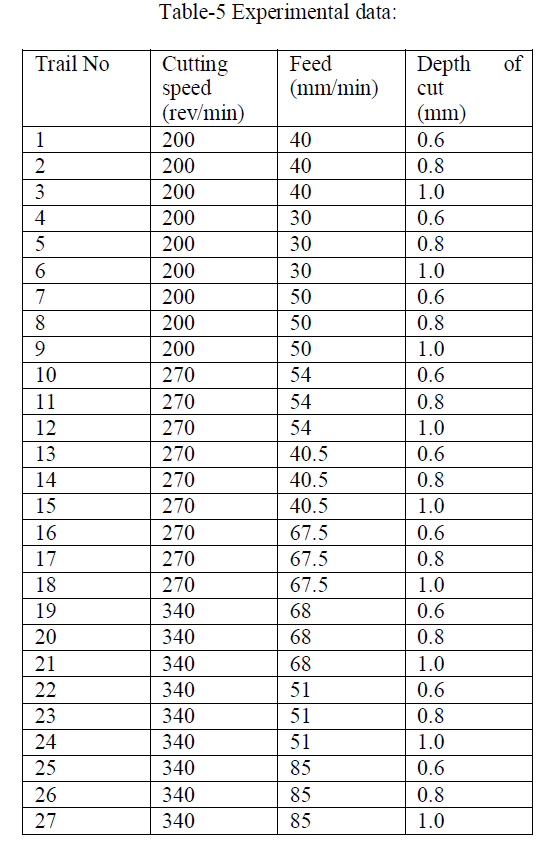 |
| CNC PROGRAM: |
| GO G28 G91 Z0; |
| G0 G17 G40 G54 G89 G90; |
| M03 S200; |
| G0 Z100.0; |
| X0.0 Y0.0; |
| G01 Z50.0 F300 M08; |
| G40 G54 G90 X0.0 Y0.0; |
| G01 Z-0.6 F40; |
| G40 G80 G0 Z100.0 M09; |
| G0 G28 G91 Z0.0 Y0.9; |
| M30; |
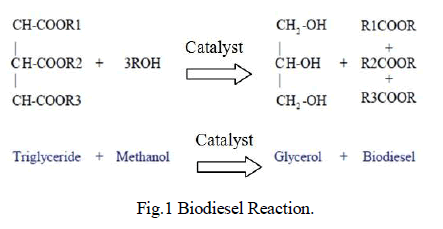 |
XI. FORMULAE |
| Now tool life can be calculated by using extended Taylor’s equation for above shown practical range of cutting parameters and results being tabulated manually then whole data is being entered into the Minitab software datasheet and optimization being carried out in Minitab software. According to the results being obtained by the Minitab, suitable suggestion should be made to improve the tool life. |
| Table-6-Taylor’s extended tool life equation we get, |
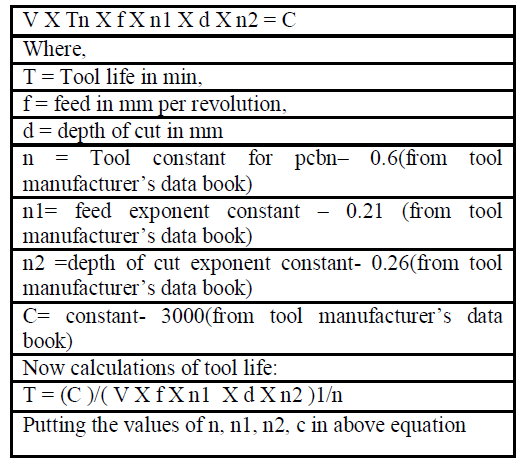 |
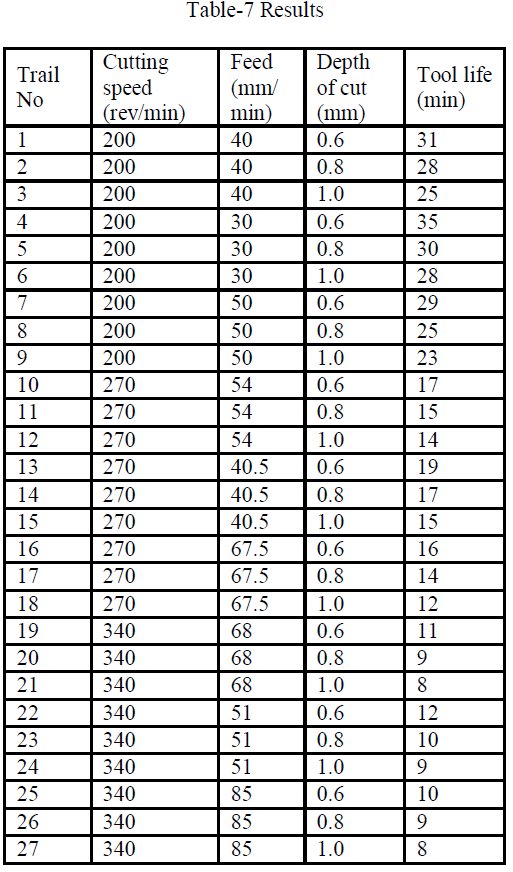 |
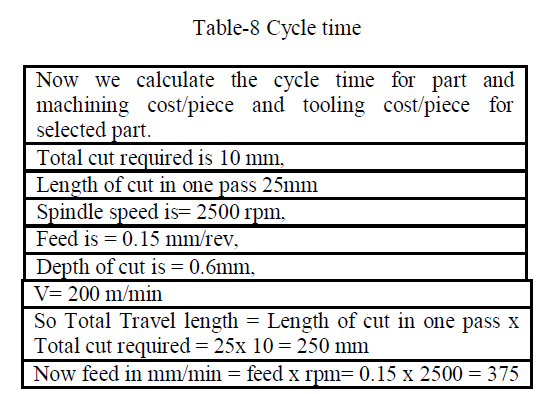  |
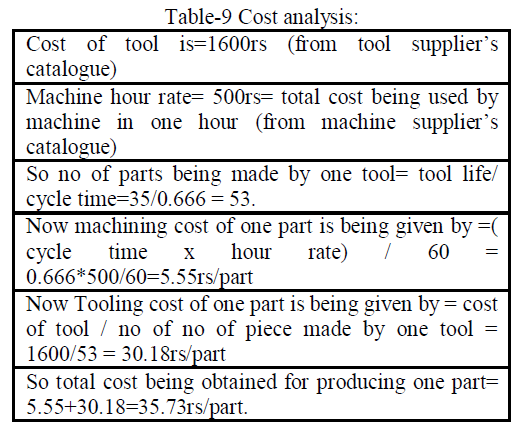 |
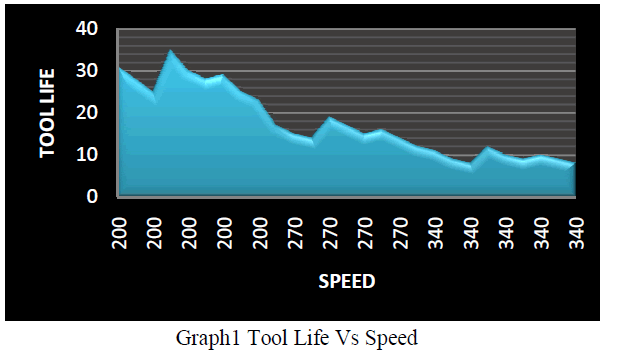 |
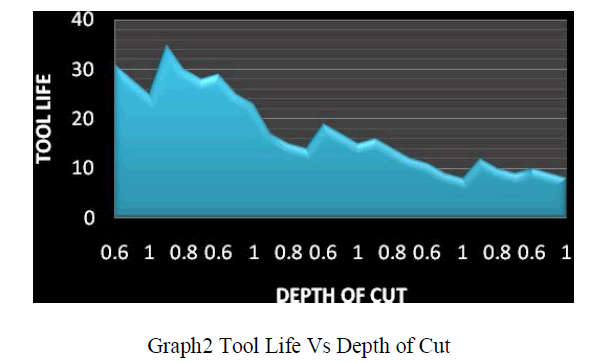 |
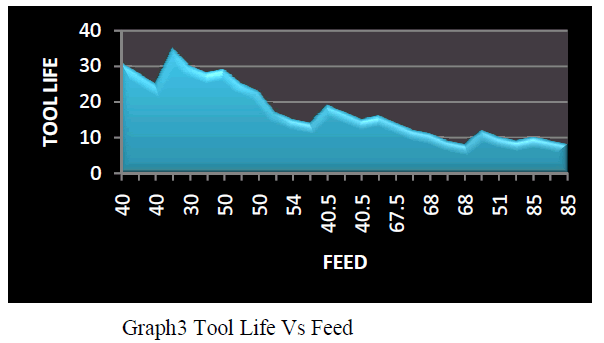 |
XII. CONCLUSION |
| As There are numbers of Parameters which affect the Tool life of end milling Cutters of CNC milling machine, According to present Work conditions and necessary Experiment set up being situated in an industry cutting parameters being chosen for experiment. Mainly Three cutting parameters named Cutting speed, Depth of cut, Feed may be selected and optimize these three parameters using taguchi method. |
| In this case The Experimental results demonstrate that the cutting speed and depth of cut are the main parameters that Influence the tool life of end mill cutters of cnc milling machine. The tool life can be improved simultaneous through taguchi method approach instead of using Engineering judgment. The confirmation experiments were conducted to verify optimal cutting parameters. |
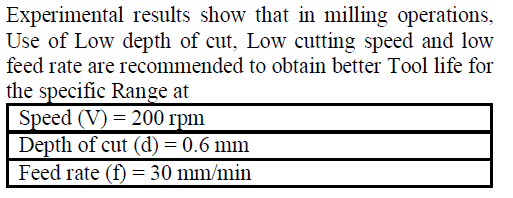 |
XIII. FUTURE SCOPE |
| One can go for the full factorial 3k design for obtaining greater results than the 2k factorial design. |
| One can also use jmp v9.0 or SAS Software rather than using Minitab for the Design of experiment .because Minitab does not give the description of the results and graphs being developed by it. |
| One can also use the shanin’s advanced Design of experiment method for the optimization of the tool life of the cnc milling machine. |
| One can also use tool rake angle and axial depth of cut as an additional factors with addition to cutting speed, feed, depth of cut, and make full factorial design of 25 or Full factorial three level design in form of 35 and can do optimization process .but it takes too much time and cost also. |
References |
|